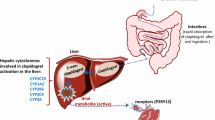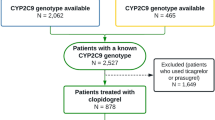Abstract
Purpose
Proton-pump Inhibitors use and CYP2C19 loss-of-function alleles are associated with reduced responsiveness to standard clopidogrel doses and increased cardiovascular events.
Methods
Post-myocardial infarction patients heterozygous (wild type [wt]/*2, n = 41) or homozygous (*2/*2, n = 7) for the CYP2C19*2 genetic variant were matched with patients not carrying the variant (wt/wt, n = 58). All patients were randomized to a 300- or 900-mg clopidogrel loading dose. A PK/PD model was defined using the variation of the P2Y12 reaction unit relative to baseline.
Results
Carriage of CYP2C19*2 allele and the use of omeprazole/esomeprazole were associated with the inter-individual variability in the active metabolite clearance. The relationship between inhibition of platelet aggregation (IPA, %) and the active metabolite AUC (h*μg/L) was described by a sigmoid function (Emax 56±5%; EAUC50 15.9±0.8 h*μg/L) with a gamma exponent (7.04±2.26).
Conclusion
This on/off shape explains that a small variation of exposure may have a clinical relevance.



Similar content being viewed by others
Abbreviations
- AUC0-6 :
-
Area Under the plasma concentration-time Curve from time of dose (0) to 6-h
- Cmax:
-
Maximal plasma concentration
- Clopi-H4:
-
Clopidogrel active metabolite isomer H4
- CYP2C19:
-
Cytochrome P450-2C19
- IPA:
-
Inhibition of platelet aggregation
- LC/MS/MS:
-
Liquid chromatography tandem mass spectrometry
- LD:
-
Loading dose
- LTA:
-
Light transmission aggregometry
- MACE:
-
Major adverse cardiac event
- MD:
-
Maintenance dose
- MI:
-
Myocardial infarction
- PCI:
-
Percutaneous coronary intervention
- PD:
-
Pharmacodynamic
- PK:
-
Pharmacokinetic
- POC:
-
Point of care assay
- PON1:
-
Paraoxonase-1
- PRU:
-
Platelet reaction unit
- RPA:
-
Residual platelet aggregation
- VN-P2Y12 :
-
VerifyNow™ P2Y12
References
Yusuf S, Zhao F, Mehta SR, Chrolavicius S, Tognoni G, Fox KK (2001) Effects of clopidogrel in addition to aspirin in patients with acute coronary syndromes without ST-segment elevation. N Engl J Med 345(7):494–502
Steinhubl SR, Berger PB, Mann 3rd JT, et al. (2002) Early and sustained dual oral antiplatelet therapy following percutaneous coronary intervention: a randomized controlled trial. JAMA 288(19):2411–2420
Sabatine MS, Cannon CP, Gibson CM, et al. (2005) Addition of clopidogrel to aspirin and fibrinolytic therapy for myocardial infarction with ST-segment elevation. N Engl J Med 352(12):1179–1189
Sabatine MS, Cannon CP, Gibson CM, et al. (2005) Effect of clopidogrel pretreatment before percutaneous coronary intervention in patients with ST-elevation myocardial infarction treated with fibrinolytics: the PCI-CLARITY study. JAMA 294(10):1224–1232
Angiolillo DJ (2009) Variability in responsiveness to oral antiplatelet therapy. Am J Cardiol 103(3 Suppl):27A–34A
Mega JL, Close SL, Wiviott SD, et al. (2009) Cytochrome p-450 polymorphisms and response to clopidogrel. N Engl J Med 360(4):354–362
Shuldiner AR, O’Connell JR, Bliden KP, et al. (2009) Association of cytochrome P450 2C19 genotype with the antiplatelet effect and clinical efficacy of clopidogrel therapy. JAMA 302(8):849–857
Collet JP, Hulot JS, Pena A, et al. (2009) Cytochrome P450 2C19 polymorphism in young patients treated with clopidogrel after myocardial infarction: a cohort study. Lancet 373(9660):309–317
Cayla G, Hulot JS, O’Connor S, et al. (2011) Clinical, angiographic, and genetic factors associated with ealy conrn ary stent thrombosis. JAMA 306(16):1765–1774
Collet JP, Hulot JS, Anzaha G, et al. (2011) High doses of clopidogrel to overcome genetic resistance (the CLOVIS-2 study). JACC Cardiovasc Interv 4:392–402
Mega JL, Hochholzer W, Frelinger 3rd AL, et al. (2011) Dosing clopidogrel based on CYP2C19 genotype and the effect on platelet reactivity in patients with stable cardiovascular disease. JAMA 306(20):2221–2228
Hulot JS, Bura A, Villard E, et al. (2006) Cytochrome P450 2C19 loss-of-function polymorphism is a major determinant of clopidogrel responsiveness in healthy subjects. Blood 108(7):2244–2247
Simon T, Verstuyft C, Mary-Krause M, et al. (2009) Genetic determinants of response to clopidogrel and cardiovascular events. N Engl J Med 360(4):363–375
Kazui M, Nishiya Y, Ishizuka T, et al. (2010) Identification of the human cytochrome P450 enzymes involved in the two oxidative steps in the bioactivation of clopidogrel to its pharmacologically active metabolite. Drug Metab Dispos 38(1):92–99
Hagihara K, Kazui M, Kurihara A, et al. (2009) A possible mechanism for the differences in efficiency and variability of active metabolite formation from thienopyridine antiplatelet agents, prasugrel and clopidogrel. Drug Metab Dispos 37(11):2145–2152
Li XQ, Andersson TB, Ahlstrom M, Weidolf L (2004) Comparison of inhibitory effects of the proton pump-inhibiting drugs omeprazole, esomeprazole, lansoprazole, pantoprazole, and rabeprazole on human cytochrome P450 activities. Drug Metab Dispos 32(8):821–827
Hulot JS, Wuerzner G, Bachelot-Loza C, et al. (2010) Effect of an increased clopidogrel maintenance dose or lansoprazole co-administration on the antiplatelet response to clopidogrel in CYP2C19-genotyped healthy subjects. J Thromb Haemost 8(3):610–613
Cuisset T, Frere C, Quilici J, et al. (2009) Comparison of omeprazole and pantoprazole influence on a high 150-mg clopidogrel maintenance dose the PACA (Proton Pump Inhibitors And Clopidogrel Association) prospective randomized study. J Am Coll Cardiol 54(13):1149–1153
Gaglia MA, Jr., Torguson R, Hanna N, et al. Relation of proton pump inhibitor use after percutaneous coronary intervention with drug-eluting stents to outcomes. Am J Cardiol. 2010;105(6):833–838
Ho PM, Maddox TM, Wang L, et al. (2009) Risk of adverse outcomes associated with concomitant use of clopidogrel and proton pump inhibitors following acute coronary syndrome. JAMA 301(9):937–944
Juurlink DN, Gomes T, Ko DT, et al. (2009) A population-based study of the drug interaction between proton pump inhibitors and clopidogrel. CMAJ 180(7):713–718
O’Donoghue ML, Braunwald E, Antman EM, et al. (2009) Pharmacodynamic effect and clinical efficacy of clopidogrel and prasugrel with or without a proton-pump inhibitor: an analysis of two randomised trials. Lancet 374(9694):989–997
Rassen JA, Choudhry NK, Avorn J, Schneeweiss S (2009) Cardiovascular outcomes and mortality in patients using clopidogrel with proton pump inhibitors after percutaneous coronary intervention or acute coronary syndrome. Circulation 120(23):2322–2329
Ray WA, Murray KT, Griffin MR, et al. (2010) Outcomes with concurrent use of clopidogrel and proton-pump inhibitors: a cohort study. Ann Intern Med 152(6):337–345
Sibbing D, Morath T, Stegherr J, et al. (2009) Impact of proton pump inhibitors on the antiplatelet effects of clopidogrel. Thromb Haemost 101(4):714–719
Siller-Matula JM, Spiel AO, Lang IM, Kreiner G, Christ G, Jilma B (2009) Effects of pantoprazole and esomeprazole on platelet inhibition by clopidogrel. Am Heart J 157(1):148 e141–148 e145
Small DS, Farid NA, Payne CD, et al. (2008) Effects of the proton pump inhibitor lansoprazole on the pharmacokinetics and pharmacodynamics of prasugrel and clopidogrel. J Clin Pharmacol 48(4):475–484
Stockl KM, Le L, Zakharyan A, et al. (2010) Risk of rehospitalization for patients using clopidogrel with a proton pump inhibitor. Arch Intern Med 170(8):704–710
Yun KH, Rhee SJ, Park HY, et al. (2010) Effects of omeprazole on the antiplatelet activity of clopidogrel. Int Heart J 51(1):13–16
Zuern CS, Geisler T, Lutilsky N, Winter S, Schwab M, Gawaz M (2010) Effect of comedication with proton pump inhibitors (PPIs) on post-interventional residual platelet aggregation in patients undergoing coronary stenting treated by dual antiplatelet therapy. Thromb Res 125(2):e51–e54
Hulot JS, Collet JP, Silvain J, et al. (2010) Cardiovascular risk in clopidogrel-treated patients according to cytochrome P450 2C19*2 loss-of-function allele or proton pump inhibitor Coadministration: a systematic meta-analysis. J Am Coll Cardiol 56:134–143
Angiolillo DJ, Gibson CM, Cheng S, et al. (2011) Differential effects of omeprazole and pantoprazole on the pharmacodynamics and pharmacokinetics of clopidogrel in healthy subjects: randomized, placebo-controlled, crossover comparison studies. Clin Pharmacol Ther 89:65–74
Tuffal G, Roy S, Lavisse M, et al. (2011) An improved method for specific, quantitative determination of the clopidogrel active metabolite isomers in human plasma. Thromb Haemost 105:696–705
Beal S, Sheiner L, Boeckmann AJ (eds) NONMEM user’s guide. Ellicott City (MD): Icon Development Solutions, :1989–2006
Karlsson MO, Jonsson EN, Wiltse CG, Wade JR (1998) Assumption testing in population pharmacokinetic models: illustrated with an analysis of Moxonidine data from congestive heart failure patients. J Pharmacokinet Biopharm 26:207–246
Brendel K, Comets E, Laffont C, Laveille C, Mentre F (2006) Metrics for external model evaluation with an application to the population pharmacokinetics of gliclazide. Pharm Res 23:2036–2049
Navarese EP, Andreotti F, Schulze V, Kołodziejczak M, Buffon A, Brouwer M, Costa F, Kowalewski M, Parati G, Lip GY, Kelm M, Valgimigli M (2015) Optimal duration of dual antiplatelet therapy after percutaneous coronary intervention with drug eluting stents: meta-analysis of randomised controlled trials. BMJ 350:h1618
Mauri L, Kereiakes DJ, Yeh RW, Driscoll-Shempp P, Cutlip DE, Steg PG, Normand SL, Braunwald E, Wiviott SD, Cohen DJ, Holmes Jr DR, Krucoff MW, Hermiller J, Dauerman HL, Simon DI, Kandzari DE, Garratt KN, Lee DP, Pow TK, Ver Lee P, Rinaldi MJ, Massaro JM (2014) DAPT study investigators. Twelve or 30 months of dual antiplatelet therapy after drug-eluting stents. N Engl J Med 371:2155–2166
Conflict of interest
The authors declare no competing interest.
Authors’ contributions
N. Simon wrote the manuscript and performed the analysis.
J. Finzi, G. Cayla, and G. Montalescot designed and performed the research.
J-P. Collet and J-S. Hulot wrote the manuscript, and designed and performed the research.
Author information
Authors and Affiliations
Corresponding author
Electronic supplementary material
ESM 1
(DOCX 81 kb)
Rights and permissions
About this article
Cite this article
Simon, N., Finzi, J., Cayla, G. et al. Omeprazole, pantoprazole, and CYP2C19 effects on clopidogrel pharmacokinetic-pharmacodynamic relationships in stable coronary artery disease patients. Eur J Clin Pharmacol 71, 1059–1066 (2015). https://doi.org/10.1007/s00228-015-1882-3
Received:
Accepted:
Published:
Issue Date:
DOI: https://doi.org/10.1007/s00228-015-1882-3




